Ulises Flores
13/10/2019
Greetings dear Stem-reader!
Through this post I share some ecological aspects to improve our relationship with biodiversity and nature in general. Feel free to appreciate the perfect relationship and balance between bees and plants. It is a millenary and necessary natural relationship, which today is going through severe anthropogenic effects (caused by man) that threaten its existence and therefore biodiversity.
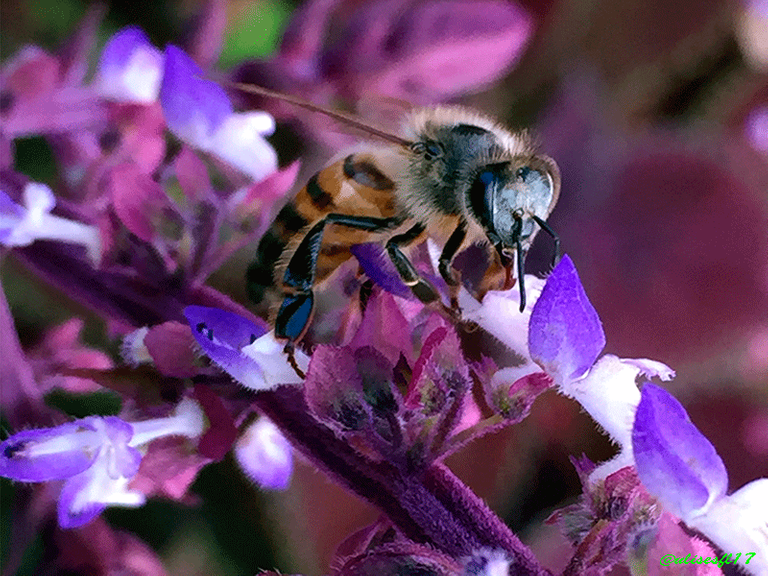
Lavender melliferous flowers are visited by a specimen Apis mellifera
If you are curious to know in a simple and didactic way this biological cycle (plant and bee), your brain will be gratifying you the intelligent decision with a good amount of endorphins, since the chromatic combination and harmonious images are combined with the thematic content to make segregate biochemicals of happiness. So, enjoy reading with confidence!

The honey bee (Apis mellifera) is a species of apocrit insect member of the apex family, taxonomically classified by the naturalist scientist Carlos Linneo in 1758. Its phylogenetic tree is still scrutinized roots, a few years ago was disclosed in Nature Genetics the results of a study conducted by a team of researchers from various countries, which states that the primitive ancestors of Apis mellifera originated on the Asian continent and not in Africa as believed.
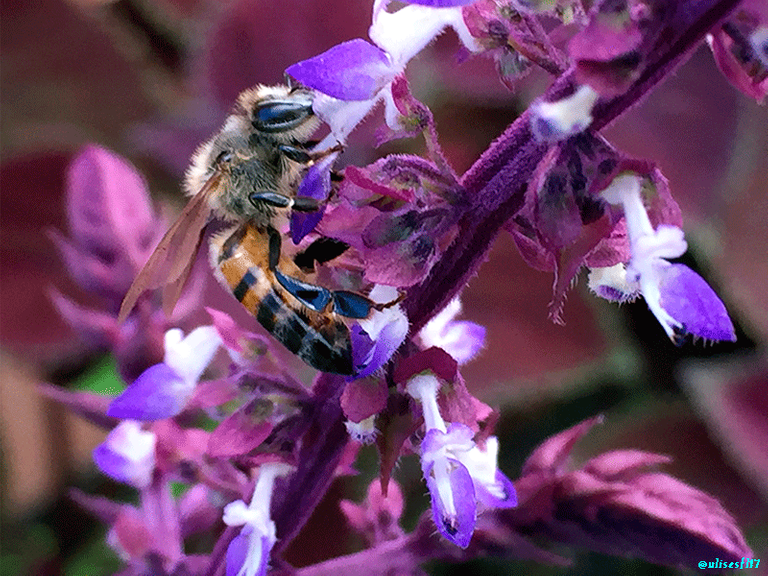
Right vertical profile of the Apis mellifera
This evolutionary tree of the hymenoptera would have germinated about 300 million years ago, beginning the Mesozoic era, geological time that corresponds with the formation of the supercontinent Pangea, having given the continental rearrangement were generated better conditions that allowed the origin and adaptation of various species, including primitive bees that were characterized by being entomophagous, ie they fed on smaller insects that lurked in the flowers.
With the evolutionary process underway and the environmental variations, they experienced a change of food habit and became nectivorous species, then go from insectivorous to feed on nectar and pollen of the melliferous flora, for example, the specimen of the image is feeding on this striking lavender plant (Lavandula angustifolia), appreciated for its fragrant aroma, attractive violet color and succulent nectar.

Honey bees can reach a length of 15 mm proportional to its oval shape with an average body width of 5 mm are amber with dark tones and yellow rings. Depending on its genetic purity the black color could replace the amber and predominate in its body, while the tone of its striae could change from dark to softer.
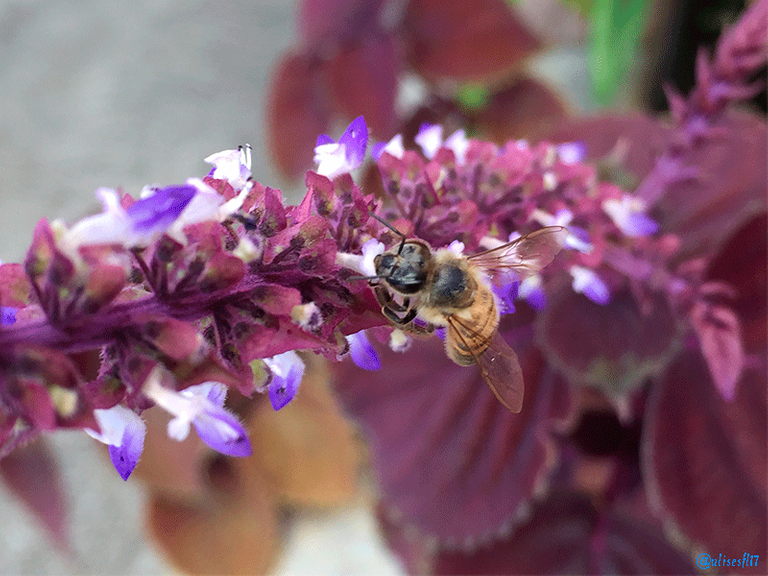
Their chromatic nature is within the best defense devices, without diminishing the importance of the fearsome sting. Animals with well pronounced colors are respected by their predators, is a biological mechanism that by natural law warns opportunistic species, predators and others who try to invade or assault their demarcated territory.
These creatures are able to mobilize their nerves wings more than 220 times per second, thus generating a fearsome hum during their flight. In the images there is hardly a pair of transparent wings, visible thanks to the veins which are fine conductive lines of haemolymph (blood of these insects). However, they have two pairs of wings on each side, a pair of upper and lower wings; this makes possible their stability during the flight, especially as they are carriers by nature.
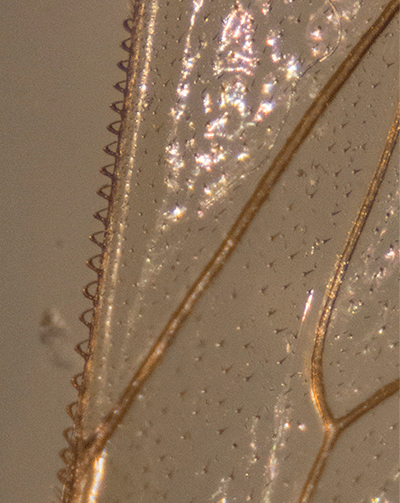 |
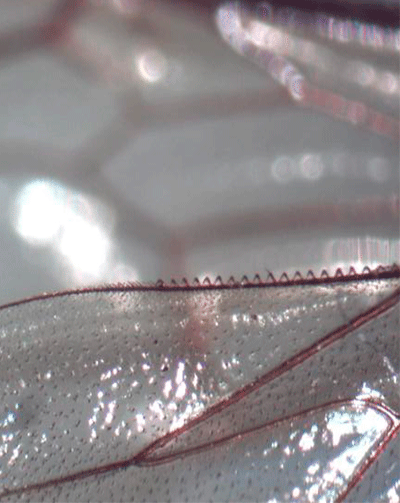 |
Attribution and thanks to @phage93, who provided this documentary evidence where you can see the hooks on the edges of the flaps, which are called hamuli.
However, when they are ready to fly, they deploy the wing and, in turn, a synchronous attachment of the upper and lower wing (on each side); this through tiny hooks that hook perfectly to function as a single wing that defies the aerodynamic laws. As you can deduce, these wings do not have a muscular system that allows their rapid flapping, the movements are produced thanks to the work of the thoracic muscles where the upper limbs fit.
Hamuli are hook-like setae on the anterior margin of the hind wing which interlock with the recurved posterior edge of the fore wing in the Hymenoptera during flight, making them functionally two winged. The possession of hamuli is an autapomorphy for the Hymenoptera. Three types of hamuli are distinguishable: basal hamuli, distal hamuli and secondary hamuli...Source
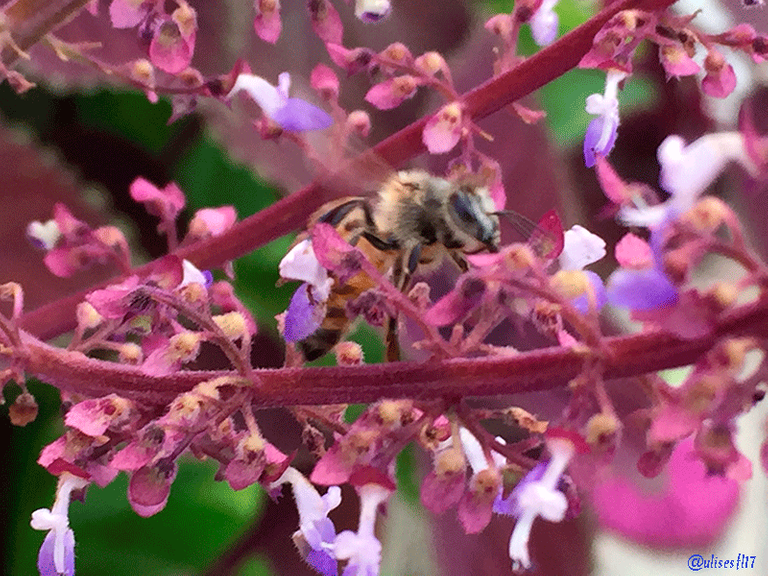
Another biophysiological characteristic is that the honeybee adapted its organism not to hibernate, it does not enter a lethargic state like other species of bees. The Apis mellifera is a social species and is organized in a colony where it narrows in community during the winter, this allows it to control body temperature and feed on stored food.

Due to their biophysiological behavior and division of labor, these insects have a high level of community organization. Namely, on the scale of eusocial animals; the analogy could be made with the legendary Spartan army of classical Greece. With their disciplined organizational character they stratify their colonial caste into a queen, workers and drones.
In the monarchic colony of the Apis he gave a coup d'état to the Darwinian theory on evolution and sexual relation in the species. For the Queen bee, she only has the right to have the males, which are called drones, to mate and fertilize. In this way, once she has copulated and is fertilized, she will be able to lay fertilized eggs, from which worker bees will be born (not fertile).
Now you wonder where the males (drones) come from. They are born from the spawning of infertile eggs that the Queen herself generates through a complex embryonic process of unfertilized eggs where several factors intervene, this process is known as Parthenogenesis. Parthenogenesis.
The worker bees are infertile females. They secrete the wax used to build the combs and are also responsible for cleaning and maintaining the hive, rearing the larvae, monitoring the combs and collecting nectar and pollen. Source
The life cycle of workers is relatively short, about 90 days, although depending on the use of its stinger, a modified organic appendage of the abdominal gland, capable of poisoning animals or people causing severe pain from the puncture and transmitting poisonous toxins. However, when trying to remove it, the abdominal gland tears and the bee dies.
Unlike worker bees, drones do not have stings. Their main function within the colonial organization is to copulate and fertilize the queen, a sexual process that takes place during flight. Once the sexual act is finished, the drone dies, since his reproductive system suffers a genital tear.

The pollination process is essential for biota in general, it is through the transport and dispersion of pollen that is generated and ensures the vegetable biomass in greater proportion. Pollen containers located in the anthers of angiosperms (with flowers) are full of tiny grains.
When pollinating animals and specifically honey bees come into contact with flower stamens when they are extracting nectar, their hairy bodies, wings, legs and antennae become impregnated with pollen; in this way, as they go from flower to flower and through different plants, flying miles away to search for and transport food, pollen is spread. So important is the biological and environmental function of these insects that FAO has recognized their vital work:
Pollination is a fundamental process in both natural and human-managed terrestrial ecosystems. It is vital for food production and human livelihoods and directly links wild ecosystems and agricultural production systems. Source

The environmental impact on these pollinators par excellence has been noted in several beekeeping countries. Although it is a multifactorial problem, it highlights the variations in temperature, precipitation and droughts caused by climate change; environmental pollution from industrialization based on technologies that do not adjust the parameters and permissible emission levels of gaseous effluents.
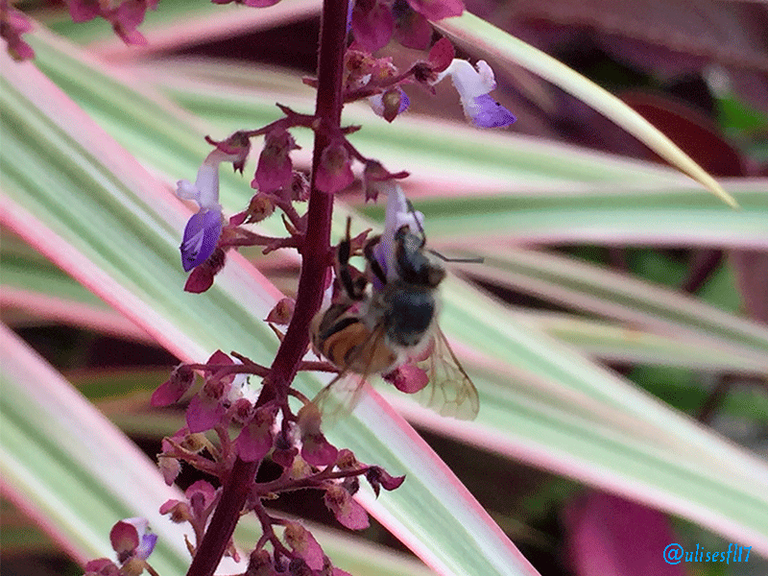
On the other hand, agricultural production methods that indiscriminately use agrochemicals that have been breaking the ecosystem balance between plants and bees are alarming. The consequences of these deleterious (deadly) actions worry environmental organizations, FAO and beekeepers. The losses are not confined to the economic or social because of the decrease in the production of honey and wax, but go beyond the crematory.
The extermination of pollinators drastically reduces plant biomass and therefore food, this impacts on wildlife herbivorous and also carnivorous because it is a system as such ... It is urgent to rethink our modes of production of goods and services, including the agricultural component. So much for my description of this noble pollinator species.

References
- Abeja melífera link
- Acción mundial de la FAO sobre servicios de polinización para una agricultura sostenible link
- Apis mellifera link
- Cuál es la importancia de las abejas link
- Hamuli in the Hymenoptera (Insecta) and their phylogenetic implications link
- Historia evolutiva de las abejas link
- Las abejas y el medio ambiente link
- Las abejas vienen de Asia link

All photographs were taken by the author in a garden at a shopping mall in Maturín, Monagas state - Venezuela, characterized by a tropical savanna climate. We used mobile equipment camera Iphone 6 plus with varied focus and distance.
For the elaboration of titles photoshop cs6 was used. The images used in the titling are of public domain and are lodged in the bank of images Pixabay.
For the elaboration of titles photoshop cs6 was used. The images used in the titling are of public domain and are lodged in the bank of images Pixabay.



Questo post è stato condiviso e votato dal team di curatori di discovery-it.
This post was shared and voted by the curators team of discovery-it
Thank you for the recognition and support. Very useful @phage93, the images you gave me. I appreciate your support and sense of collaboration.
Good vibe.
:)
@tipu curate
Upvoted 👌
Thank you for considering this publication. I appreciate your support.
Good morning.
Gracias por compartir tu contenido con la comunidad de El Arca (@elarca), el mismo ha sido votado por nuestra iniciativa de curación artística @stellae. Si deseas puedes delegar SP al proyecto: Delegate 25 SP Delegate 50 SP Delegate 100 SP Delegate 250SP Delegate 500SP o seguir nuestro trail de curación en Steem Auto. Recuerda usar los tags palnet y creativecoin para obtener mayores recompensas.
Hola apreciados amigos de la comunidad #El Arca, agradecido de su valioso reconocimiento y apoyo brindado a través de la curenta de curación @stellae. Muchas gracias.
Buena vibra.
This post has been voted on by the SteemSTEM curation team and voting trail. It is elligible for support from @curie and @minnowbooster.
If you appreciate the work we are doing, then consider supporting our witness @stem.witness. Additional witness support to the curie witness would be appreciated as well.
For additional information please join us on the SteemSTEM discord and to get to know the rest of the community!
Thanks for having used the steemstem.io app. This granted you a stronger support from SteemSTEM. Note that including @steemstem in the list of beneficiaries of this post could have yielded an even more important support.
Thank you for considering this publication. I appreciate your support.
Good morning.